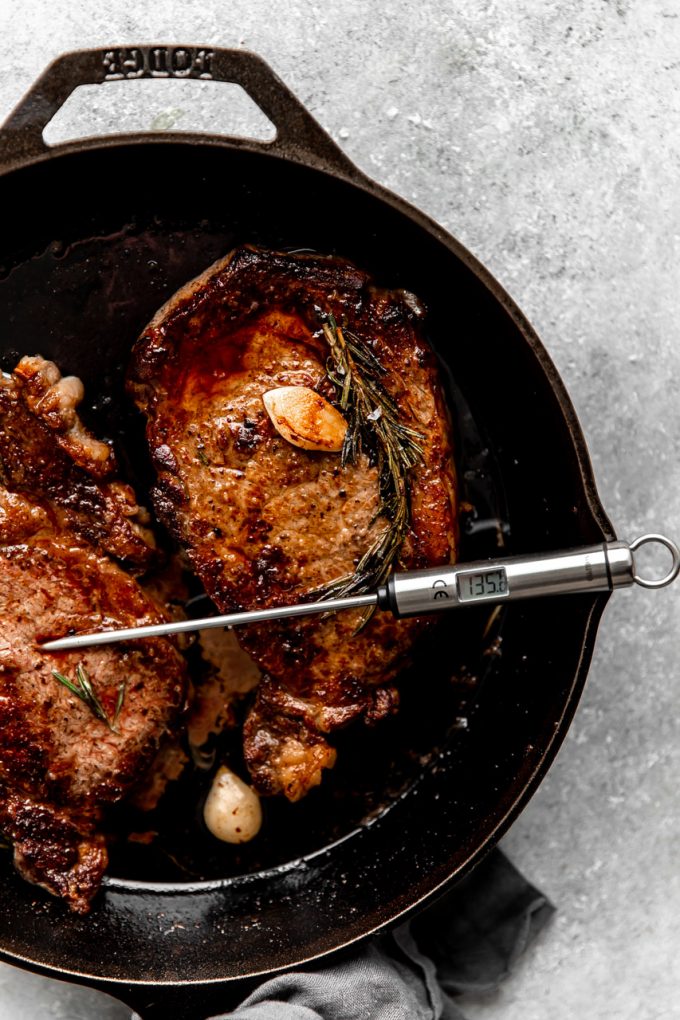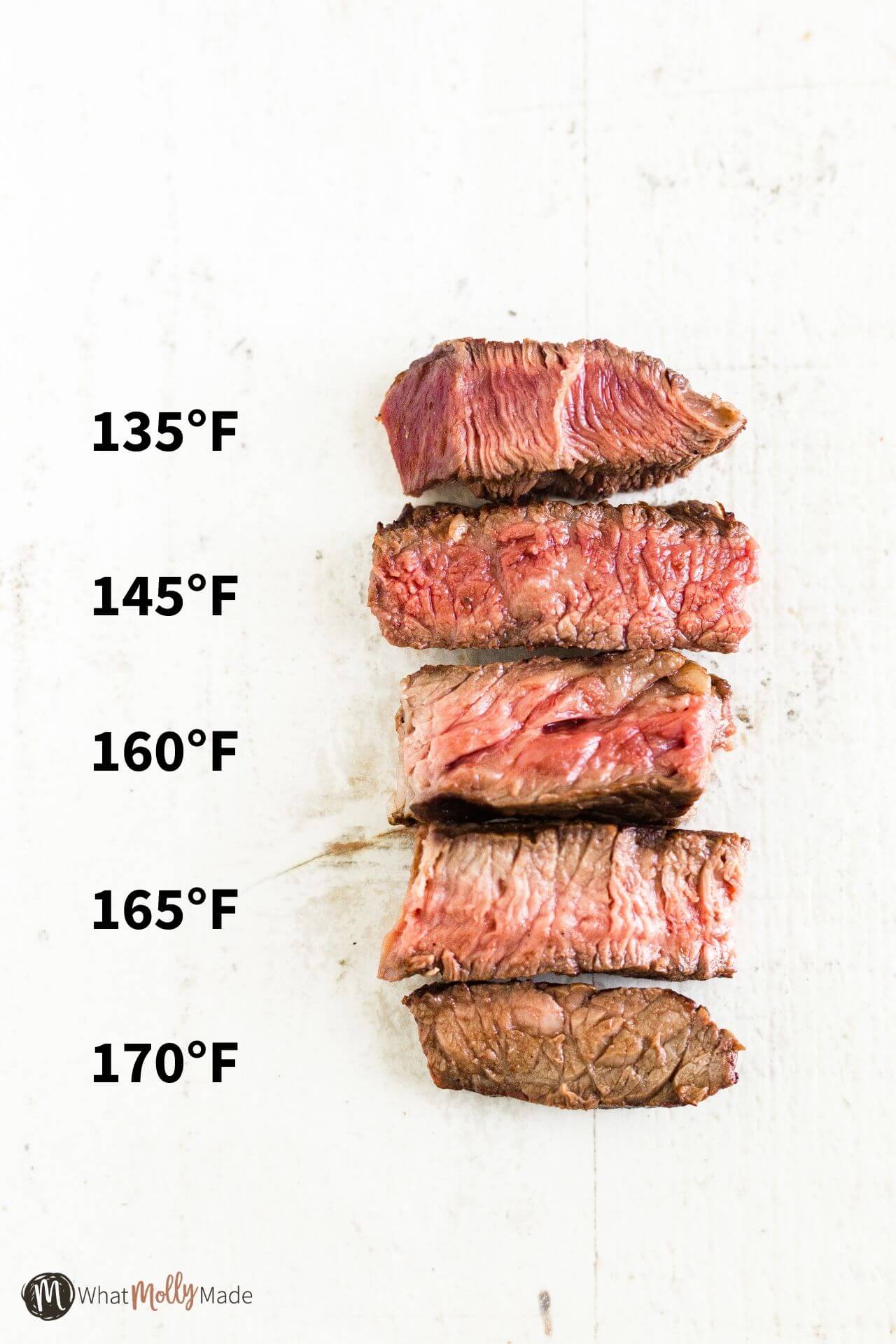How To Cook Steak To 135F: Guide To Medium-Rare Perfection
Is achieving the perfect steak a culinary quest? Mastering the art of steak doneness, especially the coveted medium-rare, is within reach for any home cook, unlocking a world of flavor and texture.
The pursuit of steak perfection often begins with temperature, a precise measurement that dictates the final result. Unlike a rare steak, which retains a cool center, medium-rare offers a balance: a warm, inviting core of red, yielding to a slightly firmer texture. This desirable outcome is achieved by cooking the steak to an internal temperature of 130 to 135 degrees Fahrenheit (55 to 57 degrees Celsius). This range represents the sweet spot for medium-rare, but understanding the subtleties involved is crucial.
The following table summarizes the key temperature ranges and the resulting doneness levels for steak, offering a clear guide for achieving your desired outcome:
| Doneness | Internal Temperature (F) | Internal Temperature (C) | Characteristics |
|---|---|---|---|
| Rare | 120-130 | 49-54 | Cool red center |
| Medium Rare | 130-135 | 55-57 | Warm red center |
| Medium | 135-140 | 57-60 | Hot pink center |
| Medium Well | 140-150 | 60-66 | Mostly brown center, firm texture |
| Well Done | 150+ | 66+ | Fully cooked, firm, potentially dry |
This understanding of temperatures is crucial. While visual cues, such as the color of the inside of the steak and its firmness, can provide hints, a meat thermometer remains the most reliable tool for accurate readings. Inserting the metal probe into the thickest part of the steak ensures an accurate measurement, guiding you towards the desired doneness.
For those seeking the ideal balance of flavor, texture, and juiciness, medium-rare reigns supreme. It is the most popular steak doneness, the temperature most commonly recommended by waiters when you order a steak at a restaurant. The meat will be cooked through enough, providing a satisfying experience. The center of the steak will be just barely warmed through, giving you a perfect combination of flavor and texture.
When grilling, achieving medium-rare involves a combination of heat and timing. Season the steak generously with salt, pepper, and olive oil. Cooking it for approximately 10 minutes per side, or until the internal temperature reaches 135 degrees Fahrenheit, is a good starting point. However, the cooking time will vary depending on the thickness of the steak and the heat of your grill. Allow the steak to rest for about 5 minutes before slicing and serving. This resting period allows the juices to redistribute, resulting in a more tender and flavorful final product.
- Alice Rosenblum Latest News Leaks Videos Whats Trending
- Alice Rosenblum Unveiling Leaks Onlyfans More Latest Info
Medium steak is light pink inside with no red center. As with medium rare, the only way to get a true reading is with a meat thermometer. A medium well steak will have a mostly brown center and firm texture. The meat will be drier as water evaporates during the cooking process.
For the home cook, the ideal target is often medium-rare. Cooked until the internal temperature of the thickest part of the steak is at 135 degrees Fahrenheit, its a great way to get the ideal flavor and texture of a steak. Now we are hitting the ideal restaurant quality steak. The longer cooker time will make your steak slightly drier and the bite less tender. This ensures the center of the steak remains warm, while the exterior develops a flavorful crust.
Grilling until the steaks reach 135 degrees F for medium rare will give the perfect result, the cook time may vary, depending on the thickness and type of steak.
When it comes to safety, the USDA guidelines recommend cooking steak to at least 145 degrees Fahrenheit, followed by a 3-minute rest. As long as the internal temperature of the steak reaches at least 125 degrees Fahrenheit, the outside will cook and is safe to eat.
Tri tip steak is a delicious and versatile cut of beef that can be cooked in a variety of ways. The medium rare steak temperature is the most popular steak doneness.
For those who prefer to cook Filet Mignon in the oven, preheat the oven to 415 degrees. Brush olive oil on filets, followed by a sprinkle of salt and black pepper. Remember, internal temperature is the key!
Beyond grilling and pan-searing, the sous vide method offers another pathway to steak perfection. Sous vide allows for precise temperature control, holding the steak at the desired temperature for an extended period. While you only need to hold red meat at a core temp for 4 minutes at 145F (63C) to make it safe, you can hold it at other temperatures for varying amounts of time to still reach a similar degree of safety.
Adjust the time as needed for your preferred doneness). Also, steak doneness can also be estimated by checking the color of the inside of the steak and its firmness, but the only way to get a true reading is with a meat thermometer.
Here's a quick reference guide for Temperature conversion
| Temperature (F) | Temperature (Celsius) | Notes |
|---|---|---|
| 120-125 | 49-52 | Rare |
| 130-135 | 54-57 | Medium Rare |
| 135-140 | 57-60 | Medium |
| 140-150 | 60-66 | Medium Well |
| 150+ | 66+ | Well Done |
Remember that with salmon, the internal temperature of the fish is most important. Salmon has almost no collagen, which means it will start to lose moisture more quickly than beef.
Mastering the art of steak cooking is a journey, and with each attempt, you'll refine your skills and discover your personal preferences. Armed with the right tools, knowledge, and a little patience, you can confidently create a steak that is perfectly cooked every time.
Article Recommendations



Detail Author:
- Name : Prof. Earnest Kertzmann DDS
- Username : carolyn05
- Email : zstokes@hodkiewicz.com
- Birthdate : 2001-10-01
- Address : 34953 Brando Road North Newtonfurt, CO 99284
- Phone : 408-367-7882
- Company : Yost, Welch and Rohan
- Job : Musical Instrument Tuner
- Bio : Earum voluptatem alias et eligendi dolorum. Consequuntur a ut dolor recusandae et. Non eaque quam voluptatum molestias et qui quae architecto. Accusantium corporis ut cumque sit cum quia et.
Socials
instagram:
- url : https://instagram.com/jeromy.greenfelder
- username : jeromy.greenfelder
- bio : Non autem laboriosam ad quibusdam eveniet. Alias eum corporis soluta maiores.
- followers : 3688
- following : 1854
linkedin:
- url : https://linkedin.com/in/greenfelderj
- username : greenfelderj
- bio : Error ut quo dolorem delectus autem omnis.
- followers : 2160
- following : 940